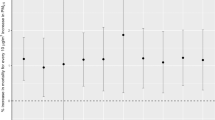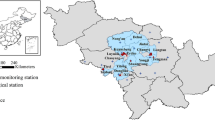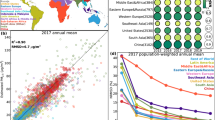Abstract
Epidemiologic studies on acute effects of air pollution have generally been limited to larger cities, leaving questions about rural populations behind. Recently, we had developed a spatiotemporal model to predict daily PM2.5 level at a 1 km2 using satellite aerosol optical depth (AOD) data. Based on the results from the model, we applied a case-crossover study to evaluate the acute effect of PM2.5 on mortality in North Carolina, South Carolina, and Georgia between 2007 and 2011. Mortality data were acquired from the Departments of Public Health in the States and modeled PM2.5 exposures were assigned to the zip code of residence of each decedent. We performed various stratified analyses by age, sex, race, education, cause of death, residence, and environmental protection agency (EPA) standards. We also compared results of analyses using our modeled PM2.5 levels and those imputed daily from the nearest monitoring station. 848,270 non-accidental death records were analyzed and we found each 10 μg/m3 increase in PM2.5 (mean lag 0 and lag 1) was associated with a 1.56% (1.19 and 1.94) increase in daily deaths. Cardiovascular disease (2.32%, 1.57–3.07) showed the highest effect estimate. Blacks (2.19%, 1.43–2.96) and persons with education ≤8 year (3.13%, 2.08–4.19) were the most vulnerable populations. The effect of PM2.5 on mortality still exists in zip code areas that meet the PM2.5 EPA annual standard (2.06%, 1.97–2.15). The effect of PM2.5 below both EPA daily and annual standards was 2.08% (95% confidence interval=1.99–2.17). Our results showed more power and suggested that the PM2.5 effects on rural populations have been underestimated due to selection bias and information bias. We have demonstrated that our AOD-based exposure models can be successfully applied to epidemiologic studies. This will add new study populations in rural areas, and will confer more generalizability to conclusions from such studies.
This is a preview of subscription content, access via your institution
Access options
Subscribe to this journal
Receive 6 print issues and online access
$259.00 per year
only $43.17 per issue
Buy this article
- Purchase on Springer Link
- Instant access to full article PDF
Prices may be subject to local taxes which are calculated during checkout




Similar content being viewed by others
References
Samet JM, Dominici F, Curriero FC, Coursac I, Zeger SL . Fine particulate air pollution and mortality in 20 U.S. cities, 1987-1994. N Engl J Med 2000; 343: 1742–1749.
Wichmann HE, Spix C, Tuch T, Wölke G, Peters A, Heinrich J et al. Daily mortality and fine and ultrafine particles in Erfurt, Germany part I: role of particle number and particle mass. Res Rep Health Eff Inst 2000; 98: 5–86; discussion 87–94.
Mar TF, Ito K, Koenig JQ, Larson TV, Eatough DJ, Henry RC et al. PM source apportionment and health effects. 3. Investigation of inter-method variations in associations between estimated source contributions of PM2.5 and daily mortality in Phoenix, AZ. J Expos Sci Environ Epidemiol 2005; 16: 311–320.
Boldo E, Medina S, Le Tertre A, Hurley F, Mücke HG, Ballester F et al. Apheis: health impact assessment of long-term exposure to PM2.5 in 23 European cities. Eur J Epidemiol 2006; 21: 449–458.
Ostro BD, Broadwin R, Lipsett MJ . Coarse and fine particles and daily mortality in the Coachella Valley, California: a follow-up study. J Expo Anal Environ Epidemiol 2000; 10: 412–419.
Franklin M, Zeka A, Schwartz J . Association between PM2.5 and all-cause and specific-cause mortality in 27 US communities. J Expos Sci Environ Epidemiol 2006; 17: 279–287.
Ruchirawat M, Settachan D, Navasumrit P, Tuntawiroon J, Autrup H . Assessment of potential cancer risk in children exposed to urban air pollution in Bangkok, Thailand. Toxicol Lett 2007; 168: 200–209.
Risom L, Moller P, Loft S . Oxidative stress-induced DNA damage by particulate air pollution. Mutat Res 2005; 592: 119–137.
Dockery DW . Health effects of particulate air pollution. Ann Epidemiol 2009; 19: 257–263.
Valavanidis A, Fiotakis K, Vlachogianni T . Airborne particulate matter and human health: toxicological assessment and importance of size and composition of particles for oxidative damage and carcinogenic mechanisms. J Environ Sci Health C Environ Carcinog Ecotoxicol Rev 2008; 26: 339–362.
Brenner H, Savitz DA, Jockel KH, Greenland S . Effects of nondifferential exposure misclassification in ecologic studies. Am J Epidemiol 1992; 135: 85–95.
Greenland S . Divergent biases in ecologic and individual-level studies. Stat Med 1992; 11: 1209–1223.
Lee M, Kloog I, Chudnovsky A, Lyapustin A, Wang Y, Melly S et al. Spatiotemporal prediction of fine particulate matter using high-resolution satellite images in the Southeastern US 2003-2011. J Expos Sci Environ Epidemiol 2015 (e-pub ahead of print 17 June 2015; doi: 10.1038/jes.2015.41).
Maclure M . The case-crossover design: a method for studying transient effects on the risk of acute events. Am J Epidemiol 1991; 133: 144–153.
Medina-Ramon M, Schwartz J . Temperature, temperature extremes, and mortality: a study of acclimatisation and effect modification in 50 US cities. Occup Environ Med 2007; 64: 827–833.
Atkinson RW, Kang S, Anderson HR, Mills IC, Walton HA . Epidemiological time series studies of PM2.5 and daily mortality and hospital admissions: a systematic review and meta-analysis. Thorax 2014; 69: 660–665.
Franklin M, Zeka A, Schwartz J . Association between PM2.5 and all-cause and specific-cause mortality in 27 US communities. J Expo Sci Environ Epidemiol 2007; 17: 279–287.
Ostro B, Broadwin R, Green S, Feng WY, Lipsett M . Fine particulate air pollution and mortality in nine California counties: results from CALFINE. Environ Health Perspect 2006; 114: 29–33.
Schwartz J, Coull B, Laden F, Ryan L . The effect of dose and timing of dose on the association between airborne particles and survival. Environ Health Perspect 2008; 116: 64–69.
Lepeule J, Laden F, Dockery D, Schwartz J . Chronic exposure to fine particles and mortality: an extended follow-up of the Harvard Six Cities Study from 1974 to 2009. Environ Health Perspect 2012; 120: 965–970.
Kloog I, Nordio F, Zanobetti A, Coull BA, Koutrakis P, Schwartz JD . Short term effects of particle exposure on hospital admissions in the mid-Atlantic states: a population estimate. PLoS One 2014; 9: e88578.
Acknowledgements
This publication was made possible by USEPA grant RD 83479801. Its contents are solely the responsibility of the grantee and do not necessarily represent the official views of the USEPA. Further, USEPA does not endorse the purchase of any commercial products or services mentioned in the publication.
Author information
Authors and Affiliations
Corresponding author
Ethics declarations
Competing interests
The authors declare no conflict of interest.
Rights and permissions
About this article
Cite this article
Lee, M., Koutrakis, P., Coull, B. et al. Acute effect of fine particulate matter on mortality in three Southeastern states from 2007–2011. J Expo Sci Environ Epidemiol 26, 173–179 (2016). https://doi.org/10.1038/jes.2015.47
Received:
Accepted:
Published:
Issue Date:
DOI: https://doi.org/10.1038/jes.2015.47
Keywords
This article is cited by
-
Short term exposure to air pollution and mortality in the US: a double negative control analysis
Environmental Health (2022)
-
Comparison of PM2.5 Concentrations in Cities of Varying Population Size Across Mississippi, USA
Water, Air, & Soil Pollution (2022)
-
Low Levels of Air Pollution and Health: Effect Estimates, Methodological Challenges, and Future Directions
Current Environmental Health Reports (2019)



